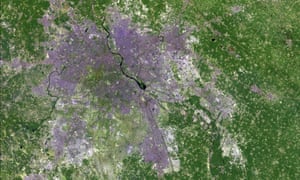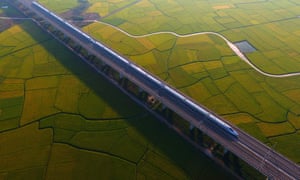Growing mega-cities will displace vast tracts of farmland by 2030, study says
Cropland losses will have consequences especially for Asia and Africa, which will experience growing food insecurity as cities expand
Our future crops will face threats not only from climate change, but also from the massive expansion of cities, a new study warns. By 2030, it’s estimated that urban areas will triple in size, expanding into cropland and undermining the productivity of agricultural systems that are already stressed by rising populations and climate change.
Roughly 60% of the world’s cropland lies on the outskirts of cities—and that’s particularly worrying, the report authors say, because this peripheral habitat is, on average, also twice as productive as land elsewhere on the globe.
“We would expect peri-urban land to be more fertile than average land, as mankind tends to settle where crops can be produced,” says Felix Creutzig from the Mercator Research Institute on Global Commons and Climate Change in Berlin, and principal author on the paper. “However, we were ignorant about the magnitude of this effect.” The agricultural losses they calculated in the study, published in Proceedings of the National Academy of Sciences, translates to a 3 to 4% dip in global agricultural production.
This may not appear to be a huge figure at first glance, but on the regional scale the picture changes. Across countries and different crops, the effects of this loss vary and become more intense. In Africa and Asia especially—which together bear 80% of the projected loss due to rising urbanisation in these regions—urban expansion will consign farmers to an even tougher agricultural reality.
To arrive at the estimates, the researchers combined datasets on cropland location, productivity, and projected urban expansion by 2030. By superimposing these layers of information on one other, they could highlight the locations where cropland and urban spread are expected to intersect in the future. These projections reveal hotspots of loss in countries like Egypt, Nigeria, the countries that flank Lake Victoria in East Africa, and in Eastern China. (China alone is expected to experience one-quarter of the global cropland loss.)
A major worry surrounding the disappearance of this productive land is the impact it will have on staple crops such as maize, rice, soya beans, and wheat, which are cornerstones of global food security. Many of these crops occur in areas that will be consumed by urban spread in years to come. “Due to urbanisation in Nigeria, 17% of rice production and 12% of maize production will be hampered,” Creutzig says. “Egypt will lose more than 40% of its rice, and more than 60% of its maize.” In Africa, there will a 26% continental loss of wheat. Rice is forecast to suffer the most, with a 9% global decline, occurring predominantly in Asia where the bulk of this crop grows.
Creutzig notes that some of this loss can be compensated for by agricultural expansion and intensification. But again, this isn’t possible everywhere on the planet: many regions are already limited by their inability to adapt to urban encroachment.
For instance, in South Asia farmland can’t simply spread elsewhere, because fertile land is already running out. In India, agricultural expansion would force crops into habitats like wetlands that act as important buffers against flooding and sea-level rise. And in North Africa, worsening conditions driven by climate change will make the land that is available less suitable for farming. “Urbanisation pressure adds to other stresses on the food system, notably climate change,” Creutzig says.
This will undermine food security, with countries worst affected by urban expansion experiencing rising dependence on imports. That will leave them vulnerable to global fluctuations in food supply, and could also price crops out of reach of poorer populations.
Creutzig sees other subtler food security impacts at play as well—like the ousting of millions of smallscale farmers, as cities expand. These farmers produce the majority of food in developing countries—and so are instrumental to global food security. “As peri-urban land is converted, smallholders will lose their land,” he says. “The emerging mega-cities will rely increasingly on industrial-scale agricultural and supermarket chains, crowding out local food chains.”
“In cases where farmers have no formal land rights, such as in Africa, governments may expel farmers from their land,” commented Anton Van Rompaey, a geographer from the Katholieke Universiteit Leuven in Belgium, who was not part of the study but has has done research on urban spread and its agricultural impacts in China. “In the past this has led to social instability and deadly conflicts between farmers and government.”
Facing this disturbing future food map, Creutzig predicts that growing food within the city’s margins—urban farming—could be part of the solution. “Urban agriculture is of course utterly insufficient to feed the urban population, but it is very important to maintain local supply chains and provide livelihoods and subsistence for urban farmers,” he says. However, regulations on expansion, to keep urbanisation as compact as possible, will be the bigger prerogative of cities, Creutzig says.
After the COP22 climate conference in November this year, there was a call to shift power from the national level to cities, which will be key players in curbing emissions and fighting global climate change. With croplands on the periphery of these urban hubs in peril, ensuring food security is set to become an important part of that mandate, too.


No comments:
Post a Comment